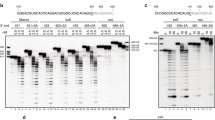Abstract
Hyperprocessing is defined as a further processing of mature RNA that produces another functional RNA. Hyperprocessing occurs inDrosophila cells. In the transposoncopia-related retrovirus-like particles ofDrosophila, a 39-nucleotide-long fragment from the 5′-region ofDrosophila initiator methionine tRNA is used as the primer forcopia minus-strand reverse transcription. This primer tRNA fragment is thought to be produced by cleavage within the mature tRNA sequence. We found that the catalytic RNA subunit of RNase P catalyzes this hyperprocessingin vitro and that this cleavage is dependent of the occurrence of an altered conformation of the tRNA substrate. In this review, I will summarize our work from the finding of the functional RNA fragment to the finding of a dynamic tRNA structure
Similar content being viewed by others
Abbreviations
- HIV-1:
-
type 1 human immunodeficiency virus
- kb:
-
kilobases
- LTR:
-
long terminal repeat
- PBS:
-
primer binding site
- RVLPs:
-
retrovirus-like particles
- tRNA Met i :
-
initiator methionine tRNA
References
Abelson J (1979) Annu. Rev. Biochem. 48: 1035–1069
Kikuchi Y, Sasaki N & Ando-Yamagami Y (1990) Proc. Natl. Acad. Sci. USA 87: 8105–8109
Kikuchi Y & Sasaki N (1992) J. Biol. Chem. 267: 11972–11976
Kikuchi Y, Ando Y & Shiba T (1986) Nature 323: 824–826
Shiba T & Saigo K (1983) Nature 302: 119–124
Harada F, Peters GG & Dahlberg JE (1979) J. Biol. Chem. 254: 10979–10985
Varmus H & Swanstrom R (1982) In: Weiss R, Teich N, Varmus H & Coffin J (Eds) Molecular Biology of Tumor Viruses: RNA Tumor Viruses 2nd Ed (pp. 369–512). Cold Spring Harbor Lab, Cold Spring Harbor, NY
Voytas DF & Boeke JD (1993) Trends Genet. 9: 421–427
Kuroda K, Kagiyama-Takahashi R & Shinomiya T (1990) J. Biochem. 108: 926–933
Shinomiya T & Ina S (1991) Nucleic Acids Res. 14: 3935–3941
McClain WH, Guerrier-Takada C & Altman S (1987) Science 238: 527–530
Altman S (1989) Adv. Enzymol. Relat. Areas Mol. Biol. 62: 1–36
Flavell AJ & Brierley C (1986) Nucleic Acids Res. 14: 3659–3669
Khan R & Giedroc DP (1992) J. Biol. Chem. 267: 6689–6695
Litvak S, Sarih-Cottin L, Fournier M, Andreola M & Tarrago-Litvak L (1994) Trends Biochem. Sci. 19: 114–118
Götte M, Fackler S, Hermann T, Perola E, Cellai L, Gross HJ, Le Grice SFJ & Heumann H (1995) EMBO J. 14: 833–841
Maizels N & Weiner AM (1993) In: Gesteland RF & Atkins JF (Eds) The RNA World (pp. 557–602) Cold Spring Harbor Lab, Cold Spring Harbor, NY
Author information
Authors and Affiliations
Rights and permissions
About this article
Cite this article
Kikuchi, Y. RNase P as hyperprocessing enzyme: A model for formation of a biologically functional tRNA fragment. Mol Biol Rep 22, 171–175 (1995). https://doi.org/10.1007/BF00988724
Issue Date:
DOI: https://doi.org/10.1007/BF00988724




